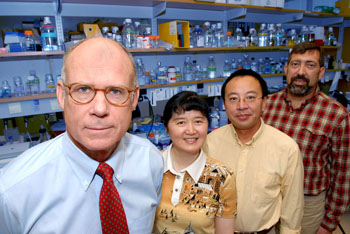
Robert Coffey, M.D., and colleagues, from left, Jennie Cao, M.D., Ph.D., Cunxi Li, M.D., Ph.D., and James Higginbotham, Ph.D. (photo by Susan Urmy)
Investigators create new method to study cell ‘delivery trucks’
Location, location, location. For proteins in epithelial cells — the cells that line tissues like the lungs, kidneys and gastrointestinal tract — setting up shop in just the right place is critical to cell function.
In a first-of-its-kind study, Robert Coffey, M.D., and colleagues have isolated and characterized the “delivery trucks” — small membrane-enclosed vesicles — that route proteins to certain parts of the cell membrane.
Their findings, featured on the cover of the September issue of Molecular & Cellular Proteomics, provide an initial inventory of the protein content of vesicles headed to the basolateral membrane, a special part of the epithelial cell surface that in vivo abuts the blood supply.
“We think this is a significant advance,” said Coffey, professor of Medicine and Cell & Developmental Biology. “Until now, basolateral vesicles have never been isolated in sufficient quantity and purity to perform such a large-scale analysis.”
Coffey believes that the team's novel methods for isolating vesicles, sorting the vesicles using a fluorescence-based approach, and applying proteomic analysis to determine protein content will be broadly useful.
“We're confident that we can apply this approach to isolating and characterizing any cellular organelle now,” he said. “This is an enabling technology that will be provided through the newly formed Epithelial Biology Center.”
The new center, directed by Coffey and James Goldenring, M.D., Ph.D., has the premise that altered vesicle trafficking (failure of the delivery trucks to make their deliveries) will underlie multiple diseases. It will be important, he said, to understand the differences in vesicle content between normal and disease conditions — an area where Vanderbilt investigators can now excel.
Cunxi Li, M.D., Ph.D., research assistant professor of Medicine, had previously demonstrated that TGF-alpha, a growth factor important in epithelial cells and some human cancers, is a cargo delivered by specialized vesicles to the basolateral membrane.
The group also showed that a molecule called Naked2 interacts with TGF-alpha, coating the vesicles and escorting them to the membrane. By attaching a fluorescent “tag” to Naked2, the researchers could follow the “glow” of the vesicles as they traversed the cell. They found that a particular modification of Naked2 caused the vesicles to accumulate at the basolateral membrane — the vesicles traveled to the right spot, but couldn't fuse with the membrane and “make the delivery.”
Taking advantage of this delivery-stopping modification of Naked2, Jennie Cao, M.D., Ph.D., devised a strategy to biochemically enrich the trapped vesicles, and then with James Higginbotham, Ph.D., used fluorescence-activated vesicle sorting to isolate the vesicles based on their “glow.”
In collaboration with the Mass Spectrometry Research Center Proteomics Core, the researchers identified 389 vesicle proteins in three independent experiments. They used other methods to confirm that six of these proteins co-localized with Naked2 in cells expressing the non-modified form of Naked2.
“We think we can now apply this methodology to sorting any cellular organelle, as long as there is a protein in that organelle that can be tagged with a fluorescent marker,” Coffey said. The Epithelial Biology Center intends to offer the technology to investigators at Vanderbilt and elsewhere, he added.
Other contributors to the current study include Jeffrey Franklin, Ph.D., David Tabb, Ph.D., Ramona Graves-Deal, Salisha Hill, Kristin Cheek, W. Gray Jerome, Ph.D., Lynne Lapierre, Ph.D., James Goldenring, M.D, Ph.D., and Amy-Joan Ham, Ph.D. The National Cancer Institute supported the research.
In related work, Coffey and colleagues reported this month in the Proceedings of the National Academy of Sciences that TGF-alpha protects its “escort” Naked2 from degradation, thus assuring the efficient delivery of TGF-alpha to its proper destination. They also demonstrate that this TGF-alpha action occurs independently of TGF-alpha binding to its receptor.
Coffey is the John B. Wallace Professor of Medicine and Ingram Professor of Cancer Research.













